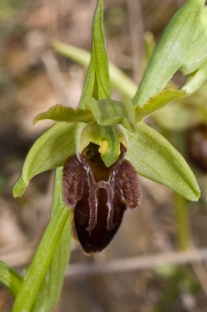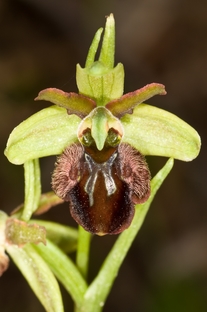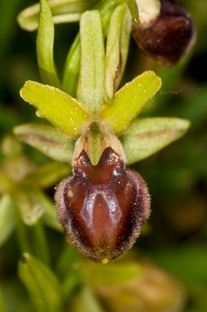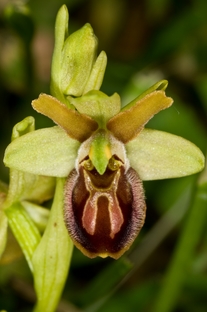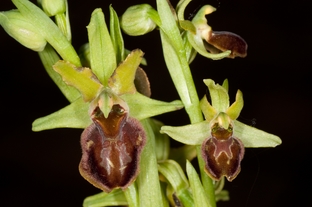 |
One of the most common
orchids in the area; in roadside banks, woodland edges, shrubby
hillsides, and hillside pastures all over the province; altitudes from 0 to 1000m;
being the earliest orchid of the Regione, one can find it
flowering from March (sometimes end of February) to the end of May.
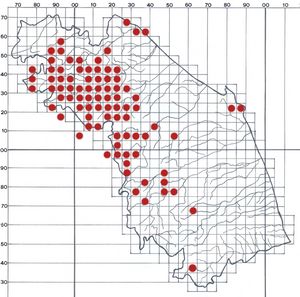
The map above only shows
part of the distribution of this species. Detailed distribution
data for the south of the Marche is needed.
The species is very variable in
flower size and shape, and remarkable variation can be found within
populations (see here). On the other hand, a number of localities in the north of
the Marche seem to show distinct characterics which need further study.
The typical form (picture
1&2) has round labellum; green petals, sometimes tending to
white; petals olive green, often with darker fringe; the basal
field characteristically of a lighter brown than the colour of
the labellum; design is variable, often H-shaped, bluish,
greyish or reddish, sometimes lined with white; generally with
rounded protuberances on the labellum;the stigmatic cave rounded
and narrowed under greenish pseudo-eyes; size of labellum
10-18mm wide.
At times the protuberances
on the labellum can be quite pronounced, often with pointed
labellum (photo 3 & 4), sometimes strongly three-lobed and hairy
on shoulders (photos 5 & 6).
More complex are
populations with very small flowers (8-10mm in width when
flattened) in dry
mountain pastures, flowering contemporaneously with N. morio
and O. pauciflora (generally O. sphegodes starts
flowering just before these). In these small-flowered forms
protuberances are often absent or weakly developed; petals are
whitish, often with a reddish tinge; the stigmatic cave is not
narrowed at the base; design proportionally big, often X like (photos
7 & 8 & 9 & 10). The landscape-oriented picture below shows
typical from and small-flowered form side by side.
Literature:
-BAGLI, L. (1990), "Aspetti
naturalistici dell'area di sperimentazione Abbazia del Moscolo - Santa
Lucia", in Quaderni di scienze della terra, pp. 55-66, Cattolica
(p.59).
-BARSALI, E. (1930), Una visita al Passo del Furlo nel mese di
maggio, Arduino, Urbino.
-CENGIA-SAMBO, M. (1929),
"Contributo alla Flora vascolare dell'Urbinate", in Nuovo Giorn. Bot.
Ital., 35(4):425-506 (p.444).
-CENTRO RICERCHE FLORISTICHE
MARCHE (1982), Flora del Massiccio Centrale del Gruppo del Monte
Catria, (inedito Pesaro), (p.47).
-CRESCENTINI, R. & J.M.I.
KLAVER, Orchidee Spontanee della Provincia Pesaro e Urbino, con
osservazioni sulle specie delle Marche, Pesaro, 1997 (p.162).
-GUBELLINI, L. (1990),
"Flora e vegetazione dei Monti del Furlo", in I Monti del Furlo,
pp. 37-88, Regione Marche (p.75).
-KLAVER, J.M.I., "Distribution
of the Orchidaceae of the Province Pesaro-Urbino (Central-East Italy)",
AHO Baden-Württemberg 23 (4), 1991, pp.557-747 (p.607-611)
-PANDOLFI, M. (1975),
"Problemi di gestione naturalistica delle risorse", Gli aspetti
naturali della provincia Pesaro e Urbino, pp. 3-12, Prov.
Pesaro-Urbino (p.20).
-PAOLUCCI, L. (1890-1),
Flora Marchigiana, Pesaro (p.119-120).
-REGIONE MARCHE (1981b),
Assessorato all'Urbanistica e all'Ambiente, Schede Delle Aree
Floristiche Delle Marche, Ancona (p.14).
-SERPIERI, A. (1867), "Erborizzazione
al Monte Catria (eseguita da R. Piccinini, piante trovate fiorite nel dė
11 giugno 1866)", in Bullettino Metereologico di Urbino,
fascicolo I, anno 1866, pp. 49-52, Urbino (p.38).
-SERPIERI, A. & A. FEDERICI
(1868), "Saggio di una flora dell'agro Urbinate ed epoca della fioritura
di molte piante. Centuria I, II, III, IV, V", in Bullettino
Metereologico di Urbino, fascicolo II, anno 1867, pp. 32-38, 48-56,
Urbino (p.35).
-ZACCARELLI, S. (1990),
"Cenni sulla flora e sulla fauna dell'area di sperimentazione Valmala",
in Quaderni di scienze della terra, pp. 47-54, Cattolica (p.47).
-ZANGHERI, P. (1966),
Flora e vegetazione del medio ed alto Appennino Romagnolo, Forlė
(p.80). |
 |

